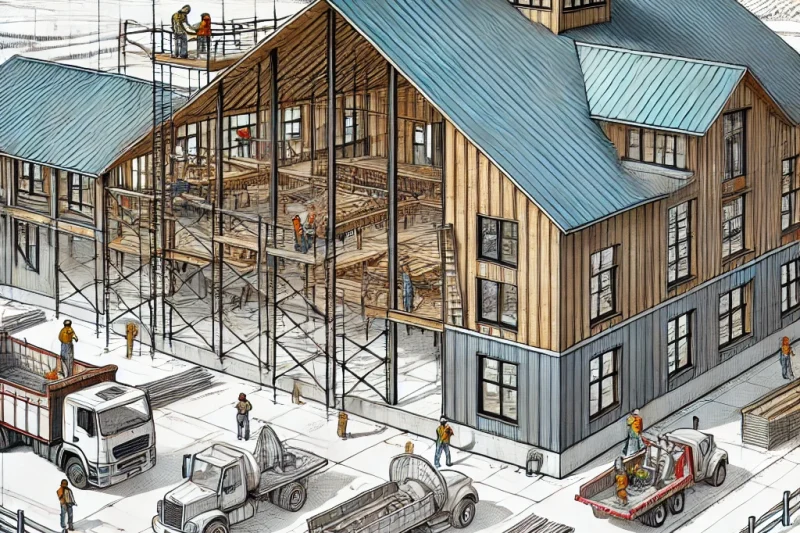Illinois USDA Loan Guide
“Unlock the Power of USDA Mortgages with Smart Mortgage!”
Illinois USDA Home Loan Guide
What is a Illinois USDA Mortgage?
Welcome to the Smart Mortgage guide on USDA Mortgages. Navigating the home financing world can be a daunting task, but understanding the various mortgage options available can significantly streamline the process. One such option that you might not be familiar with is the Illinois USDA mortgage. Let’s dive in.
1. Overview
A USDA mortgage, formally known as the USDA Rural Development Guaranteed Housing Loan, is a mortgage loan offered to rural property owners by the United States Department of Agriculture (USDA). Designed primarily to promote Illinois homeownership in rural and some suburban areas, the Illinois USDA loan comes with a range of benefits that make it a viable option for eligible homebuyers.
2. Key Features
- No Down Payment: One of the standout features of a USDA loan in Illinois is the possibility of financing up to 100% of the home’s price. This means eligible borrowers can buy Illinois home with no down payment.
- Competitive Interest Rates: Typically, USDA loans come with interest rates that are either at or below the market rate.
- Flexible Credit Guidelines: USDA loans often have more lenient credit requirements, which can be beneficial for those with a less than perfect credit history.
Illinois USDA Loan Questions Call (888)416-4805
Get cash from your home.
Apply to see how a cash out refinance can help you.
Homebuyer Seminars
Discover the keys to homeownership at our local home buying seminar – your first step towards securing your dream home!
See our home loans.
Explore our diverse range of home loan programs tailored to fit your unique needs!
3. Eligibility Criteria
To be eligible for a Illinois USDA mortgage, borrowers must meet certain requirements:
- Location: The Illinois property must be located in an eligible rural or certain suburban area as defined by the USDA.
- Income Limits: There are specific income requirements, both minimum and maximum, based on the median income of the area.
- Creditworthiness: While the USDA is generally more lenient with credit scores, a certain credit standard must still be met.
- Primary Residence: The borrower must occupy the home as their primary residence.
4. Benefits of a USDA Mortgage
- Affordability: With no down payment and the potential for lower mortgage insurance premiums, a Illinois USDA loan can be more affordable in the long run.
- Inclusive: It’s a great option for Illinois first-time homebuyers or those without a substantial savings for a down payment.
- Supporting Rural Development: By opting for a USDA mortgage, you’re indirectly supporting the development and sustainability of rural communities.
5. How Smart Mortgage Can Help
Navigating the intricacies of USDA mortgages in Illinois can be challenging. That’s where Smart Mortgage steps in. Our team of seasoned USDA mortgage professionals is here to guide you through every step, ensuring you make informed decisions tailored to your needs. Whether you have questions about your eligibility or the application process, we’re here to help.
Take the Next Step Interested in exploring if a Illinois USDA mortgage is right for you? Get in touch with our Smart Mortgage team today at (888)416-4805. We’re committed to helping you find the best mortgage solution for your unique situation.
Do you need a Pre-Approval?
We are here to help! Get a same day Illinois USDA pre-approval to shop for your dream home!
Mortgage Resource Center

USDA Loans in Illinois: Benefits, Eligibility, and Popular Cities
Buying a home is a significant milestone, and for many, finding the right loan program makes all the difference. If you're considering Read more
Barndominium Financing Made Easy with iLoanUSDA
Barndominium Financing Made Easy with iLoanUSDA: Your One-Time Construction Loan Solution Barndominiums, the stylish and practical combination Read moreMore information About Illinois
Illinois (/ˌɪlɪˈnɔɪ/ ⓘ IL-in-OY) is a state in the Midwestern United States. The Great Lakes are to its northeast, the Mississippi River to its west, and the Wabash and Ohio rivers to its south. Its largest metropolitan areas are Chicago and the Metro East region of Greater St. Louis. Other metropolitan areas include Peoria and Rockford, as well as Springfield, its capital, and Champaign-Urbana, home to the main campus of the state’s flagship university. Of the fifty U.S. states, Illinois has the fifth-largest gross domestic product (GDP), the sixth-largest population, and the 25th-largest land area.
Illinois has a highly diverse economy, with the global city of Chicago in the northeast, major industrial and agricultural hubs in the north and center, and natural resources such as coal, timber, and petroleum in the south. Owing to its central location and favorable geography, the state is a major transportation hub: the Port of Chicago has access to the Atlantic Ocean through the Great Lakes and Saint Lawrence Seaway and to the Gulf of Mexico from the Mississippi River via the Illinois Waterway. Chicago has been the nation’s railroad hub since the 1860s, and its O’Hare International Airport has been among the world’s busiest airports for decades. Illinois has long been considered a microcosm of the United States and a bellwether in American culture, exemplified by the phrase Will it play in Peoria?.
What is now Illinois was inhabited for thousands of years by various indigenous cultures, including the advanced civilization centered in the Cahokia region. The French were the first Europeans to arrive, settling near the Mississippi River in the 17th century in the region they called Illinois Country, as part of the sprawling colony of New France. Following U.S. independence in 1783, American settlers began arriving from Kentucky via the Ohio River, and the population grew from south to north. Illinois was part of the United States’ oldest territory, the Northwest Territory, and in 1818 it achieved statehood. The Erie Canal brought increased commercial activity in the Great Lakes, and the small settlement of Chicago became one of the fastest growing cities in the world, benefiting from its location as one of the few natural harbors in southwestern Lake Michigan. The invention of the self-scouring steel plow by Illinoisan John Deere turned the state’s rich prairie into some of the world’s most productive and valuable farmland, attracting immigrant farmers from Germany and Sweden. In the mid-19th century, the Illinois and Michigan Canal and a sprawling railroad network greatly facilitated trade, commerce, and settlement, making the state a transportation hub for the nation.
By 1900, the growth of industrial jobs in the northern cities and coal mining in the central and southern areas attracted immigrants from Eastern and Southern Europe. Illinois became one of America’s most industrialized states and remains a major manufacturing center. The Great Migration from the South established a large community of African Americans, particularly in Chicago, who founded the city’s famous jazz and blues cultures. Chicago became a leading cultural, economic, and population center and is today one of the world’s major commercial centers; its metropolitan area, informally referred to as Chicagoland, holds about 65% of the state’s 12.8 million residents.
Two World Heritage Sites are in Illinois, the ancient Cahokia Mounds, and part of the Wright architecture site. Major centers of learning include the University of Chicago, University of Illinois, and Northwestern University. A wide variety of protected areas seek to conserve Illinois’ natural and cultural resources. Historically, three U.S. presidents have been elected while residents of Illinois: Abraham Lincoln, Ulysses S. Grant, and Barack Obama; additionally, Ronald Reagan was born and raised in the state. Today, Illinois honors Lincoln with its official state slogan Land of Lincoln. The state is the site of the Abraham Lincoln Presidential Library and Museum in Springfield and the future home of the Barack Obama Presidential Center in Chicago.
We Service the Following Areas



